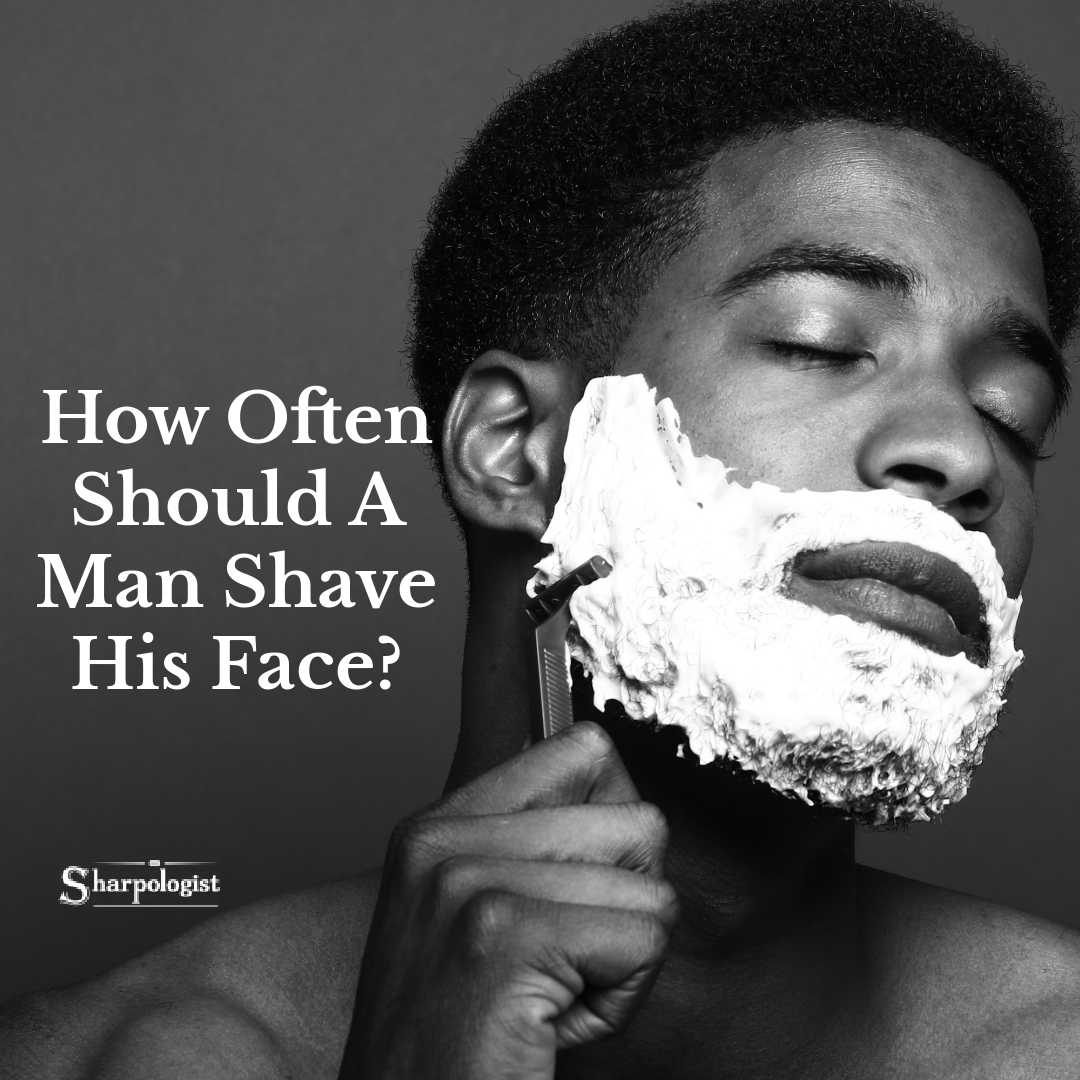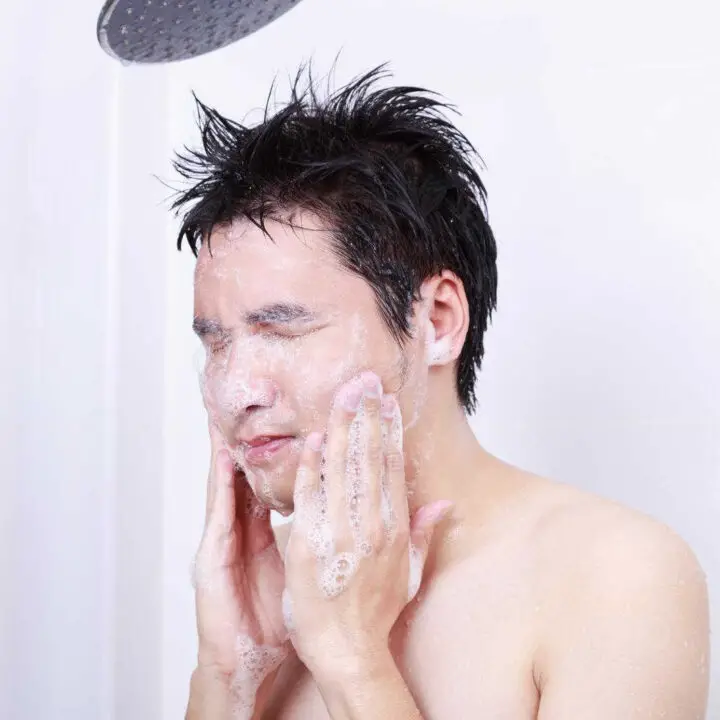
It’s a common question among men – how often should you shave your face? Depending on a number of factors, shaving every day can lead to skin irritation and other problems. Here’s a look at how often you should shave, based on your individual needs
How Often Should A Man Shave His Face?
Very broadly, without knowing specific conditions of the individual shaver and based on the variables listed in this article, I would suggest that shaving every-other-day is probably the “safest” shaving frequency.
Unfortunately I could not find any specific, scientific, peer-reviewed studies on how often should you shave so it is impossible to make an optimal estimate that would work for everyone.
Why Is It Important To Know How Often You Should Shave Your Face?
Shaving is a necessary part of facial grooming, whether you want to remain cleanly shaven or prefer a more rugged look. Shaving too often can irritate and damage your skin, so it is important to find the optimal shaving frequency for your own personal needs. This frequency can depend on a variety of factors including genetics, hair color, thickness, and growth. Knowing how often should you shave your face can help you maintain a style that is clean and professional, while avoiding skin irritation and damage.
Benefits Of Regular Facial Shaving
Regular facial shaving can help to exfoliate the skin and protect it from bacterial and fungal infections. The hair on the face can also contribute to skin irritation, which is why it’s important to shave hair from the face regularly.

Risks Of Over-Shaving
Shaving every day can cause damage to your skin’s outer protective layer and make you more susceptible to razor burn, irritation, and infection. Your skin also produces natural oils that help keep it moist and healthy – shaving too frequently will strip away these oils and leave your skin dry and irritated.
Also, if you wait too long between shaves, stubble can grow back into hair follicles and cause redness (razor burn), ingrown hairs, or folliculitis.
Factors That Influence How Often You Should Shave Your Face
The question of how often men should shave their face can be a complicated one. Factors such as skin type, hair growth rate and personal preference all play an important role in determining the frequency with which one should use a razor. Understanding what influences the decision to shave can help identify an individualized strategy that works best for you.
Profession
Some professions and jobs require a clean-shaven face for the purpose of creating a seal around the face for some kind of mask or breathing system.
Some jobs require the use–or at the least may require the use–of a portable oxygen system, including:
- Aircraft pilots
- Emergency responders (firefighters, paramedics, police officers, etc.)
- Scuba divers
- Military personnel
- Miners

Even if they don’t require portable oxygen, some jobs may require the use of a respirator, such as:
- Chemical and petrochemical workers
- Painters who work with solvents, sprays, or other chemicals
- Construction workers
Then there are jobs that may require the use of a mask but not necessarily a respirator–those that involve exposure to particulate matter or infectious agents, but the exposure levels are not high enough to require the use of a respirator, like:
- Healthcare workers
- Food service workers
- Cleaning and janitorial staff
Finally there are professions where a mask may not be required but where a clean-shaven look may be important:
- Actors
- Models
- Sales professionals
Age (And Hormones)
The effects of hormones on how often should you shave your face can be significant. During puberty, boys begin producing more testosterone, which is the male hormone responsible for many physical changes in the body. As a result, facial hair may begin to thicken and darken for teenage boys.
So it is important to be mindful of the effects of hormones on your facial hair when deciding how often to shave. Shaving too often can irritate the skin and lead to other side effects such as redness, itching, and rashes.

Hair Density
The frequency of shaving your face can be affected by hair density. Darker, more visible hairs may need more frequent shaving, whereas light-colored, less visible hairs may require fewer shaves. This is due to the fact that dark-haired individuals tend to have higher levels of testosterone, which is converted to the sex hormone DHT, meaning that their hair grows quicker and thicker than those with light-colored hair.
A healthy diet can lead to faster, more robust hair growth, which also means that you may need to shave more often.
Razor And Blade
When deciding how often to shave your face, it’s important to consider the differences between razor types. Multi-blade razors can offer a close, longer-lasting shave. However they can be more aggressive on the skin and can lead to skin irritation if not used properly. On the other hand, single, twin, and safety razors are gentler on the skin which can help prevent irritation. Electric and disposable razors offer convenience, but may not provide the desired shave.
The quality of the blade is essential when shaving. Poorly made blades are not only less effective, they can also cause skin irritation, razor burn, and other skin problems. High-quality blades such as safety, hybrid, and straight razors are designed to be gentle on the skin and provide a smoother and closer shave.
Skin Type
There are generally four main skin types:
- Normal skin: well-balanced and not too dry or oily
- Oily skin: produces excess sebum, leading to shiny skin and clogged pores
- Dry skin: lacks moisture, leading to a tight or flaky feeling and sometimes rough texture. This may require shaving less often.
- Combination skin: a mix of oily and dry areas, with the T-zone (forehead, nose, and chin) being oily and the cheeks being dry
In addition to these four main skin types, some people may have sensitive skin, which is easily irritated by certain products or environmental factors. It’s important to identify your skin type to choose appropriate skincare products and establish a suitable skincare routine.
Preference

Finally, there is personal preference. Some men may simply choose to shave more often or less often.
Tips and tricks on how to get the best shave possible
Prep your skin
Prepping your skin by cleansing with a good facial soap and lots of warm water can help you get the best shave possible by hydrating the skin and softening the facial hair. When your skin is hydrated, it helps the razor to glide easily over your skin, reducing the risk of cuts and irritation. Additionally, the increased hydration helps the facial hair to break away from the skin more readily, making for a smoother shave.
Use a Good razor With A Sharp Blade
Using a sharp razor helps you get the best shave possible by minimizing friction and drag when you shave in the direction of your hair growth. This helps avoid ingrown hairs and red bumps caused by trapped hairs. Having a sharp blade is also important because a dull blade can lead to an uneven shave, redness and blotches, patches of unshaved hair, and scraped-off patches of skin.

Use a quality shaving cream or soap
It is important to use a quality shaving product when shaving because it helps to hydrate the hairs, improve razor glide, and protect the skin from irritation. Shave creams or soaps are ideal to use because they help to lubricate the skin and keep it moist, which reduces the chances of razor burn and other forms of irritation.
Shave in multiple passes mindful of the direction of beard growth
Getting the perfect shave requires multiple passes. Using a clean and sharp razor, begin shaving with the grain of the hair growth. Go in the same direction that you can run your hand over your skin smoothly, reducing your chances of red bumps and ingrown hairs.
After the first pass, rinse your face with water and lather up again. Then, shave across the grain (90 degrees from your hair growth). This can help capture any remaining hair that was missed in the first pass.
After the second pass, rinse your face with water and lather up again. This time shave again across the grain, but from the opposite direction. Some may be able to shave this pass against the grain but use caution.
Rinse your face with cold water and pat dry. Rubbing alcohol can help heal any nicks and reduce irritation.
Finish up your shave by applying a light aftershave, moisturizer, or oil to soothe and hydrate your skin.
By following these steps, you can get the best shave possible with minimal irritation. Change the blade or use a new disposable razor after every five to seven shaves, and use razors with two or more blades for the smoothest results.
Wash afterward And Apply Aftershave Balm
It is important to wash your face after a shave in order to remove any lingering residue from the surface of your facial hair and skin. This helps to prevent skin irritation after your shave and also reduce the chances of getting razor burn or razor bumps.
After washing, applying a toning and soothing aftershave product can help to keep the pores clean, while calming the skin and preventing redness. Using an aftershave product that contains ingredients such as aloe vera and vitamin E can help to sooth the skin after shaving and provide hydration.
Conclusion
Shaving frequency is determined by a variety of factors, from genetics to personal preference. Some people may have to shave more often than others due to thicker hair growth, while some can get away with shaving less. It is important to understand the factors that influence how often you should shave and determine a routine that works best for you. With the right technique and the right razor, you can achieve a clean and comfortable shave every time without worrying about skin irritation or cuts.

Prepping Your Skin: I started using the Preshave CUBE by Phoenix Artisan Accoutrements a few months ago. It’s an amazing product. Previously, I washed my face with a high quality face soap using a FOREO Luna 3 to hydrate. But the CUBE gives me a noticeably better shave and post-shave feel, even though I already use high quality shave soaps, aftershaves, and moisturizers. Highly recommended!
Instructions:
1) Wet face and soap.
2) Apply preshave soap to whole face and neck in circular motion.
3) Scrub gently with hands.
4) Thoroughly rinse off soap. This step removes skin oils that inhibit a close shave and hydrates your beard.
5) Reapply preshave soap to face (only areas you shave) and neck in upward motion (against the grain). No need to reapply for second lather and shave pass. This step further hydrates your beard, adds slickness to shave soap, and improves post-shave feel.
6) Apply shave soap with brush over preshave soap.
Using a 24hr safety razor, I shave every day. With good prep, soap, blades, and technique, there is no irritation. In fact, I shave my whole head and face in the shower, no cleanup needed. Finish it with a cold water shower immersion and you’re ready for whatever the day throws at you.
I shave every day. I don’t like the feeling of not being shaved and while I have a full beard, the stubble hair is not particularly thick or challenging to shave, so I am lucky there.
My daily morning routine is:
1. Clean the face, usually in the shower.
2. Prep beard with water and soap residue from loading the brush (I bowl lather). This is my pre-shave.
3. Shave – standard three pass, with a mild razor and a sufficiently sharp blade. Your mileage will vary on the sufficiently sharp blade. My favorites are Tatra or Dorco Titans
4. Clean up first with water and then Thayer’s unscented witch hazel aloe vera. I rub the Thayer’s all around my face and even behind the ears. Really makes the skin feel good.
5. Finish up with an unscented balm and an aftershave splash.
Do this and I am ready to take on the world each and every day.
Comments are closed.